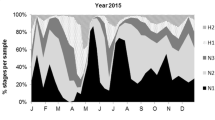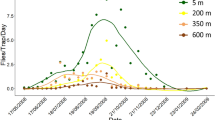Abstract
Since 2004 the oriental fruit fly, Bactrocera dorsalis (Hendel) has become widespread and economically important in Wuhan, Hubei Province, central China. In this article, the population dynamics of B. dorsalis were monitored using methyl eugenol-baited traps during 2008–2009 in Wuhan. Adults were captured from early July to the end of December in a citrus orchard and peaked in October and early November. Adult population peak coincided with the ripeness period of sweet oranges in October. Infestation with B. dorsalis was more serious in 2009 than in 2008. Field surveys of host plants for this fly species combined with rearing experiments indicated that pear was the first host plant infested by B. dorsalis. We recorded the following host shift pattern: pear (Pyrus communis L.), jujube (Zizyphus jujuba L.), persimmon (Diospyros kaki L.), and sweet orange (Citrus unshiu Marcor). Our findings suggest that B. dorsalis completes four to five generations per year in this area and most serious damage occurred in the 4th generation in the citrus orchards. The availability of preferred host fruits and the low winter temperature are key factors influencing population fluctuations. Overwintering potential experiments of adults, larvae, and pupae were also carried out in the field. Results suggest that a small proportion of pupae were able to survive winter in Wuhan and emerged successfully the following year. Practical and theoretical implications of the results regarding the invasion potential and management strategy of B. dorsalis in Hubei Province are discussed.



Similar content being viewed by others
References
Aketarawong N, Bonizzoni M, Thanaphum S, Gomulski LM, Gasperi G, Malacrida AR, Gugliemino CR (2007) Inferences on the population structure and colonization process of the invasive oriental fruit fly, Bactrocera dorsalis (Hendel). Mol Ecol 16:3522–3532
Barry JD, Miller NW, Piñero JC, Tuttle A, Mau RFL, Vargas RI (2006) Effectiveness of protein baits on melon fly and oriental fruit fly (Diptera: Tephritidae): attraction and feeding. J Econ Entomol 99(4):1161–1167
Bateman MA (1972) The ecology of fruit fly. Annu Rev Entomol 17:493–518
Chen P, Ye H (2007) Population dynamics of Bactrocera dorsalis (Diptera: Tephritidae) and analysis of factors influencing populations in Baoshanba, Yunan, China. Entomol Sci 10:141–147
Chen CX, Zheng JH, Xie JZ, Mao RQ (2009) Pest management based on petroleum spray oil in navel orange orchard in Ganzhou, South China. J Pest Sci 82:155–162
Clarke AR, Armstrong KF, Carmichael AE, Milne JR, Raghu S, Roderick GK, Yeates DK (2005) Invasive phytophagous pests arising through a recent tropical evolutionary radiation: the Bactrocera dorsalis complex of fruit flies. Annu Rev Entomol 50:293–319
Croft BA (1990) Arthropod biological control agents and pesticides. Wiley and Sons, New York
Daane KM, Johnson MW (2010) Olive fruit fly: managing an ancient pest in modern times. Annu Rev Entomol 55:151–169
Desneux N, Fauvergue X, Dechaume-Moncharmont FX, Kerhoas L, Ballanger Y, Kaiser L (2005) Diaeretiella rapae limits Myzus persicae populations following applications of deltamethrin in oilseed rape. J Econ Entomol 98:9–17
Desneux N, Denoyelle R, Kaiser L (2006a) A multi-step bioassay to assess the effect of the deltamethrin on the parasitic wasp Aphidius ervi. Chemosphere 65:1697–1706
Desneux N, Ramirez-Romero R, Kaiser L (2006b) Multi step bioassay to predict recolonization potential of emerging parasitoids after a pesticide treatment. Environ Toxicol Chem 25:2675–2682
Desneux N, Decourtye A, Delpuech JM (2007) The sublethal effects of pesticides on beneficial arthropods. Annu Rev Entomol 52:81–106
Desneux N, Wajnberg E, Wyckhuys KAG, Burgio G, Arpaia S, Narváez-Vasquez CA, González-Cabrera J, Catalán Ruescas D, Tabone E, Frandon J, Pizzol J, Poncet C, Cabello T, Urbaneja A (2010) Biological invasion of European tomato crops by Tuta absoluta: ecology, history of invasion and prospects for biological control. J Pest Sci 83:197–215
Drew RAI, Hancock DL (1994) The Bactrocera dorsalis complex of fruit flies (Diptera: Tephritidae: Dacinae) in Asia. Bull Entomol Res 2(Suppl):1–68
Duyck PF, David P, Quilici S (2004) A review of relationships between interspecific competition and invasions in fruit flies (Diptera: Tephritidae). Ecol Entomol 29:511–520
Erler F, Cetin H, Saribasak H, Serttas A (2010) Laboratory and field evaluations of some botanical pesticides against the cedar leaf moth, Acleris undulana. J Pest Sci 83:265–272
Haack RA, Herard F, Sun JH, Turgeon JJ (2010) Managing invasive populations of Asian longhorned beetle and citrus longhorned beetle: a worldwide perspective. Annu Rev Entomol 55:521–546
Han P, Niu CY, Lei CL, Cui JJ, Desneux N (2010a) Use of an innovative T-tube maze assay and the proboscis extension response assay to assess sublethal effects of GM products and pesticides on learning capacity of the honey bee Apis mellifera L. Ecotoxicology 19:1612–1619
Han P, Niu CY, Lei CL, Cui JJ, Desneux N (2010b) Quantification of toxins in a Cry1Ac + CpTI cotton cultivar and its potential effects on the honey bee Apis mellifera L. Ecotoxicology 19:1452–1459
Hou BH, Xie Q, Zhang RJ (2006) Depth of pupation and survival of the Oriental fruit fly, Bactrocera dorsalis (Diptera: Tephritidae) pupae at selected soil moistures. Appl Entomol Zool 41(3):515–520
Institute SAS (1999) SAS/Stat user’s guide, release 8. SAS Institute, Cary, NC
Isman MB (2000) Plant essential oils for pest and disease management. Crop Prot 19:603–608
Kong LB, Lin W, Li ZH, Huang GS, Liang YB (2008) Effects of climatic factors on the growth and geographical distribution of Oriental fruit fly, Bactrocera dorsalis. Chin Bull Entomol 45:528–531
Koy S, Mukhopadhyay A, Gurusubramanian G (2010) Field efficacy of a biopesticide prepared from Clerodendrum viscosum Vent. (Verbenaceae) against two major tea pests in the sub Himalayan tea plantation of North Bengal, India. J Pest Sci 83:371–377
Koyama J, Kakinohana H, Miyatake T (2004) Eradication of the melon fly, Bactrocera cucurbitae, in Japan: importance of behavior, ecology, genetics, and evolution. Annu Rev Entomol 49:331–349
Lv X, Han SC, Xu JL, Hang H, Wu H, Ou JF, Sun L (2008) Population dynamics of Bactrocera dorsalis (Hendel) in Guangzhou, Guangdong Province, with analysis of the climate factors. Acta Ecol Sin 28:1850–1856
Malacrida AR, Gomulski LM, Bonizzoni M, Bertin S, Gasperi G, Guglielmino CR (2007) Globalizatin and fruitfly invasion and expansion: the medfly paradigm. Genetica 131:1–9
Mau RFL, Jang EB, Vargas RI (2007) The Hawaii fruit fly area-wide fruit fly pest management programme: influence of partnership and a good education programme. In: Vreysen MJB, Robinson AS, Hendrichs J (eds) Area-wide control of insect pests: from research to field implementation. Springer, Dordrecht, pp 671–683
Pascual S, Cobos G, Seris E, Gonzalez-Nunez M (2010) Effects of processed kaolin on pests and non-target arthropods in a Spanish olive grove. J Pest Sci 83:121–133
Peterson MA, Denno RF (1998) The influence of dispersal and diet breadth on patterns of genetic isolation by distance in phytophagous insects. Am Nat 152(3):428–446
Pinero JC, Mau RFL, Vargas RI (2009) Managing oriental fruit fly (Diptera: Tephritidae), with spinosad-based protein bait sprays and sanitation in papaya orchards in Hawaii. J Econ Entomol 102:1123–1132
Ragsdale DW, Landis DA, Brodeur J, Heimpel GE, Desneux N (2011) Ecology and management of the soybean aphid in North America. Annu Rev Entomol 56:375–399
Rodriguez E, Gonzalez B, Campos M (2009) Effects of cereal cover crops on the main insect pests in Spanish olive orchards. J Pest Sci 82:179–185
Roy S, Gurusubramanian G, Mukhopadhyay A (2010) Neem-based integrated approaches for the management of tea mosquito bug, Helopeltis theivora Waterhouse (Miridae: Heteroptera) in tea. J Pest Sci 83:143–148
Shi W, Kerdelhue C, Ye H (2005) Population genetics of the oriental fruit fly, Bactrocera dorsalis (Diptera: Tephritidae), in Yunnan (China) based on mitochondrial DNA sequences. Environ Entomol 34(4):977–983
Stephens AEA, Kriticos DJ, Leriche A (2007) The current and future potential geographical distribution of the oriental fruit fly, Bactrocera dorsalis (Diptera: Tephritidae). Bull Entomol Res 97(4):369–378
Suckling DM, Brockerhoff EG (2010) Invasion biology, ecology, and management of the light brown apple moth (Tortricidae). Annu Rev Entomol 55:285–306
Uchida GK, Mackey BE, Mclnnis DO, Vargas RI (2007) Attraction of Bactrocera dorsalis (Diptera: Tephritidae) and nontarget insects to methyl eugenol bucket traps with different preservative fluids on Oahu Island, Hawaiian Islands. J Econ Entomol 100:723–729
Vargas RI, Miyashita O, Nishida T (1984) Life history and demographic parameters of three laboratory-reared tephritids (Diptera: Tephritidae). Ann Entomol Soc Am 77:651–656
Vargas RI, Walsh WA, Kanehisa D, Stark JD, Nishida T (2000) Comparative demography of three Hawaiian fruit flies (Diptera: Tephritidae) at alternating temperatures. Ann Entomol Soc Am 93:75–81
Vargas RI, Miller NW, Stark JD (2003) Field trials of spinosad as a replacement for naled, DDVP, and malathion in methyl eugenol and cue-lure bucket traps to attract and kill male oriental fruit flies and melon flies (Diptera: Tephritidae) in Hawaii. J Econ Entomol 96:1780–1785
Vargas RI, Mau RFL, Jang EB, Faust RM, Wong L (2008a) The Hawaii fruit fly area-wide pest management program. In: Koul O, Cuperus GW, Elliott NC (eds) Areawide IPM: theory to implementation. CABI Books, London, pp 300–325
Vargas RI, Stark JD, Hertlein M, Neto AM, Coler R, Pinero JC (2008b) Evaluation of SPLAT with spinosad and methyl eugenol or cue-lure for “attract-and-kill” of oriental and melon fruit flies (Diptera: Tephritidae) in Hawaii. J Econ Entomol 101:759–768
Vargas RI, Pinero JC, Mau RFL, Stark JD, Hertlein M, Mafra-Neto A, Coler R, Getchell A (2009) Attraction and mortality of oriental fruit flies to SPLAT-MAT-methyl engenol with spinosad. Entomol Exp Appl 131(3):286–293
Wang X (1996) Insect of Diptera Bactrocera in East Asia. Acta Zootaxon Sin 21:331–332
Ye H (2001) Distribution of the oriental fruit (Diptera: Tephritidae) in Yunnan province. Entomol Sin 8:175–182
Acknowledgments
We thank Dr. Jetske deBoer and three anonymous reviewers for valuable comments on the manuscript. This work was supported by the Chinese Agro-Industry Special Fund for Public Welfare (200903047).
Author information
Authors and Affiliations
Corresponding author
Additional information
Communicated by M. Traugott.
Rights and permissions
About this article
Cite this article
Han, P., Wang, X., Niu, CY. et al. Population dynamics, phenology, and overwintering of Bactrocera dorsalis (Diptera: Tephritidae) in Hubei Province, China. J Pest Sci 84, 289–295 (2011). https://doi.org/10.1007/s10340-011-0363-4
Received:
Accepted:
Published:
Issue Date:
DOI: https://doi.org/10.1007/s10340-011-0363-4




